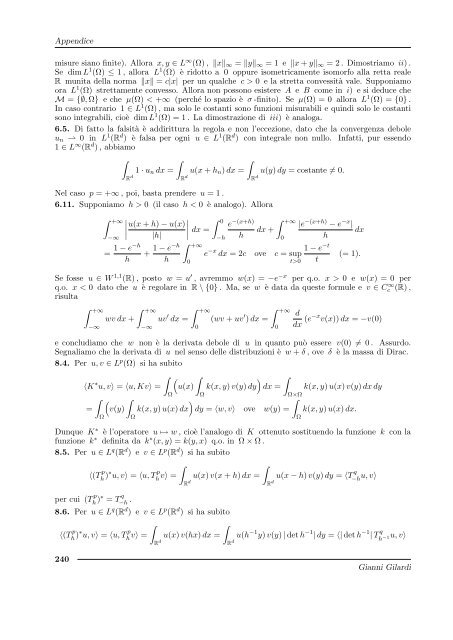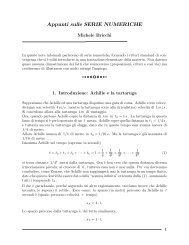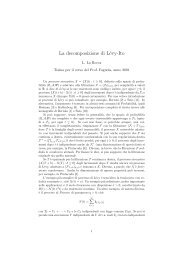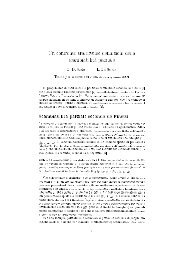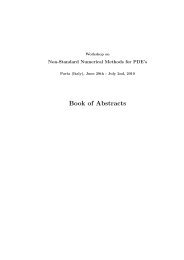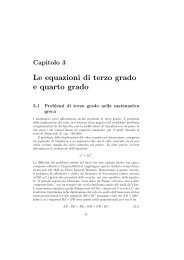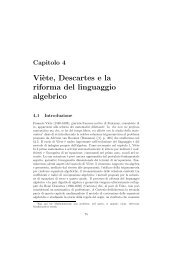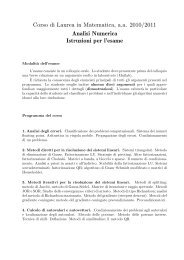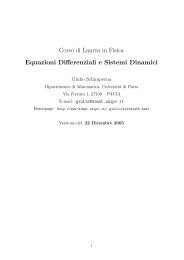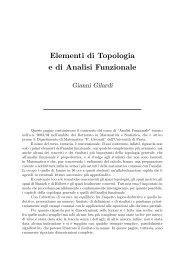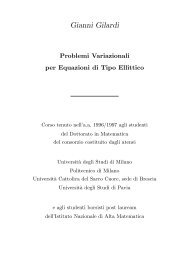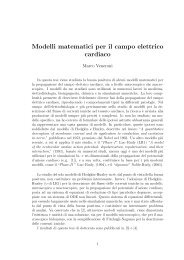G. Gilardi, Analisi Funzionale - Dipartimento di Matematica
G. Gilardi, Analisi Funzionale - Dipartimento di Matematica
G. Gilardi, Analisi Funzionale - Dipartimento di Matematica
You also want an ePaper? Increase the reach of your titles
YUMPU automatically turns print PDFs into web optimized ePapers that Google loves.
Appen<strong>di</strong>ce<br />
misure siano finite). Allora x, y ∈ L ∞ (Ω) , �x�∞ = �y�∞ = 1 e �x + y�∞ = 2 . Dimostriamo ii) .<br />
Se <strong>di</strong>m L 1 (Ω) ≤ 1 , allora L 1 (Ω) è ridotto a 0 oppure isometricamente isomorfo alla retta reale<br />
R munita della norma �x� = c|x| per un qualche c > 0 e la stretta convessità vale. Supponiamo<br />
ora L 1 (Ω) strettamente convesso. Allora non possono esistere A e B come in i) e si deduce che<br />
M = {∅, Ω} e che µ(Ω) < +∞ (perché lo spazio è σ -finito). Se µ(Ω) = 0 allora L 1 (Ω) = {0} .<br />
In caso contrario 1 ∈ L 1 (Ω) , ma solo le costanti sono funzioni misurabili e quin<strong>di</strong> solo le costanti<br />
sono integrabili, cioè <strong>di</strong>m L 1 (Ω) = 1 . La <strong>di</strong>mostrazione <strong>di</strong> iii) è analoga.<br />
6.5. Di fatto la falsità è ad<strong>di</strong>rittura la regola e non l’eccezione, dato che la convergenza debole<br />
un ⇀ 0 in L 1 (R d ) è falsa per ogni u ∈ L 1 (R d ) con integrale non nullo. Infatti, pur essendo<br />
1 ∈ L ∞ (R d ) , abbiamo<br />
�<br />
R d<br />
�<br />
1 · un dx =<br />
R d<br />
�<br />
u(x + hn) dx =<br />
Nel caso p = +∞ , poi, basta prendere u = 1 .<br />
6.11. Supponiamo h > 0 (il caso h < 0 è analogo). Allora<br />
� �<br />
�<br />
+∞<br />
�<br />
�<br />
�<br />
u(x + h) − u(x) �<br />
0<br />
�<br />
e<br />
�<br />
−∞ |h| � dx =<br />
−h<br />
−(x+h)<br />
h<br />
= 1 − e−h<br />
+<br />
h<br />
1 − e−h<br />
� +∞<br />
h<br />
0<br />
R d<br />
e −x dx = 2c ove c = sup<br />
t>0<br />
u(y) dy = costante �= 0.<br />
� +∞ |e<br />
dx +<br />
0<br />
−(x+h) − e−x |<br />
dx<br />
h<br />
1 − e −t<br />
t<br />
(= 1).<br />
Se fosse u ∈ W 1,1 (R) , posto w = u ′ , avremmo w(x) = −e −x per q.o. x > 0 e w(x) = 0 per<br />
q.o. x < 0 dato che u è regolare in R \ {0} . Ma, se w è data da queste formule e v ∈ C ∞ c (R) ,<br />
risulta<br />
� +∞ � +∞<br />
wv dx + uv ′ � +∞<br />
dx = (wv + uv ′ � +∞ d<br />
) dx =<br />
dx (e−xv(x)) dx = −v(0)<br />
−∞<br />
−∞<br />
0<br />
e conclu<strong>di</strong>amo che w non è la derivata debole <strong>di</strong> u in quanto può essere v(0) �= 0 . Assurdo.<br />
Segnaliamo che la derivata <strong>di</strong> u nel senso delle <strong>di</strong>stribuzioni è w + δ , ove δ è la massa <strong>di</strong> Dirac.<br />
8.4. Per u, v ∈ Lp (Ω) si ha subito<br />
〈K ∗ �<br />
u, v〉 = 〈u, Kv〉 =<br />
� �<br />
u(x)<br />
� �<br />
k(x, y) v(y) dy dx = k(x, y) u(x) v(y) dx dy<br />
� � �<br />
Ω<br />
�<br />
Ω<br />
Ω×Ω<br />
�<br />
= v(y) k(x, y) u(x) dx dy = 〈w, v〉 ove w(y) = k(x, y) u(x) dx.<br />
Ω<br />
Ω<br />
Dunque K ∗ è l’operatore u ↦→ w , cioè l’analogo <strong>di</strong> K ottenuto sostituendo la funzione k con la<br />
funzione k ∗ definita da k ∗ (x, y) = k(y, x) q.o. in Ω × Ω .<br />
8.5. Per u ∈ L q (R d ) e v ∈ L p (R d ) si ha subito<br />
〈(T p<br />
h )∗u, v〉 = 〈u, T p<br />
h<br />
�<br />
v〉 =<br />
R d<br />
�<br />
u(x) v(x + h) dx =<br />
per cui (T p<br />
h )∗ = T q<br />
−h .<br />
8.6. Per u ∈ Lq (Rd ) e v ∈ Lp (Rd ) si ha subito<br />
〈(T p<br />
�<br />
�<br />
v〉 = u(x) v(hx) dx =<br />
240<br />
h )∗u, v〉 = 〈u, T p<br />
h<br />
R d<br />
R d<br />
R d<br />
0<br />
Ω<br />
u(x − h) v(y) dy = 〈T q<br />
−hu, v〉<br />
u(h −1 y) v(y) | det h −1 | dy = 〈| det h −1 | T q<br />
h −1u, v〉<br />
Gianni <strong>Gilar<strong>di</strong></strong>


